| Sep 25, 2018 |
Novel label-free long-term imaging of Mitochondria in 3D enables breakthrough discovery
|
|
(Nanowerk News) Mitochondria are one of the most (if not the most) important cell organelles. They are organized in extremely dynamic networks and, in addition to supplying the cell with energy, they have an important role in apoptosis, metabolism, and degenerative diseases.
|
|
Until now it was believed that, unless specifically stained, they were not visible in microscopy. Furthermore, when fluorescent dyes are applied they are inherently phototoxic.
|
|
This strongly limits acquisition frequency and length, in order to avoid perturbations to the cell and its organelles.
|
 |
| Pre-adipocytes imaged with the 3D Cell Explorer for 1 hour at a frequency of one image per five seconds. Dynamic details of fusions, fissions and mitochondrial network remodeling can be observed.
|
|
By using an entirely new label-free technique called holotomographic microscopy (HTM), a team from the Global Health Institute at Ecole Polytechnique Fédérale de Lausanne in a collaboration with the company Nanolive SA, demonstrated that it is possible to image mitochondria label-free, over long periods of time ("Label free 3D analysis of organelles in living cells by refractive index shows pre-mitotic organelle spinning in mammalian stem cells").
|
|
Thanks to the extremely powerful time resolution of this technology (one 3D image every 2 seconds) dynamic processes such as mitochondrial fission or fusion, apoptosis and mitochondrial network remodeling could be monitored.
|
|
Similarly, lipid droplet dynamics were followed and quantified over time, highlighting unique dynamic features of cellular lipid accumulation.
|
|
Furthermore, thanks to the absence of phototoxicity proper of HTM and the unique capability to observe multiple cell organelles at once, it is possible to follow the dynamics of mitochondria, lipid droplets, nuclei as well as those of endocytic structures in live cells over long periods of time.
|
|
This has been proven possible even in the most sensitive type of cells (e.g. stem cells) which led the Life Science Faculty at EPFL to observe, to their knowledge for the first time, a global organelle spinning occurring before mitosis.
|

